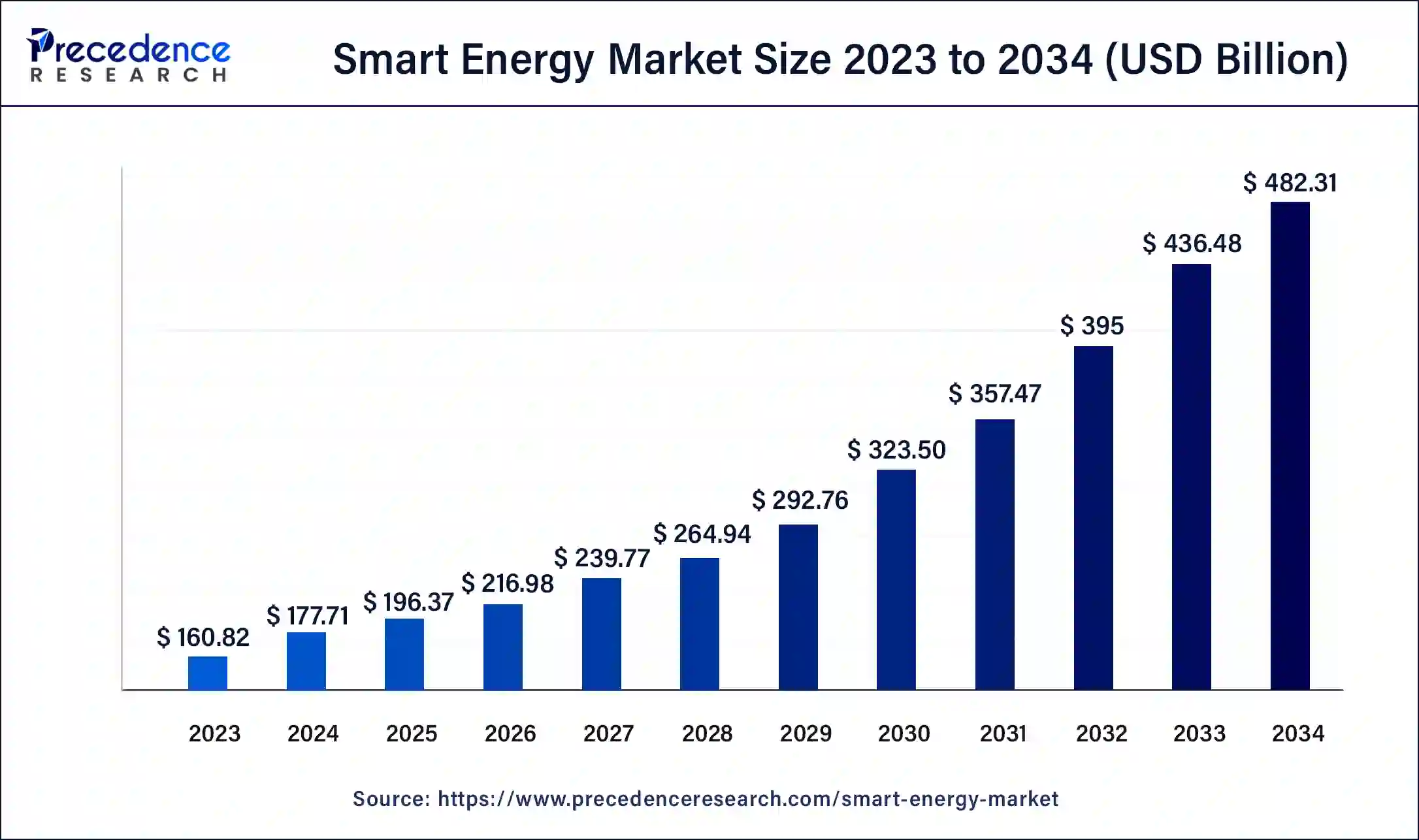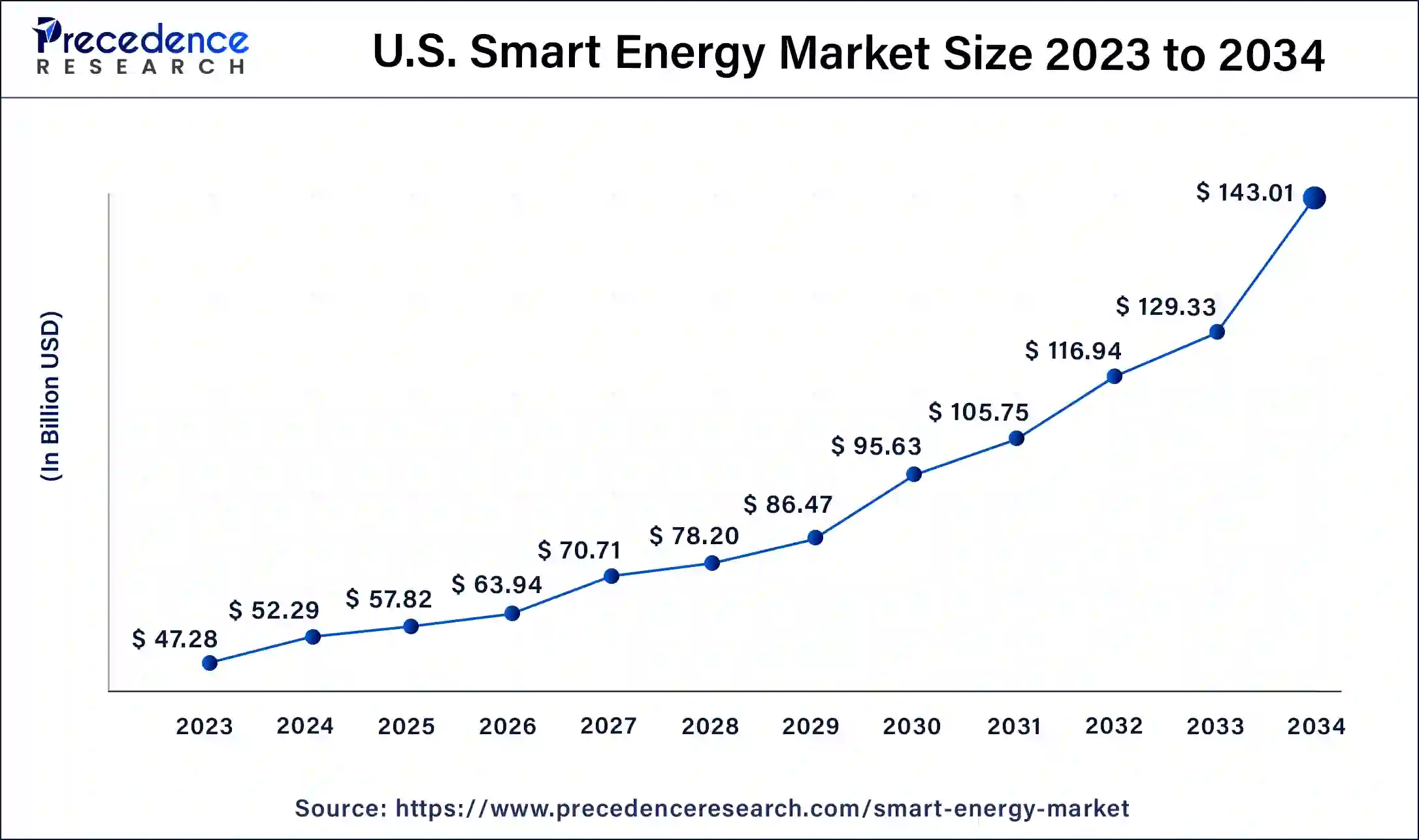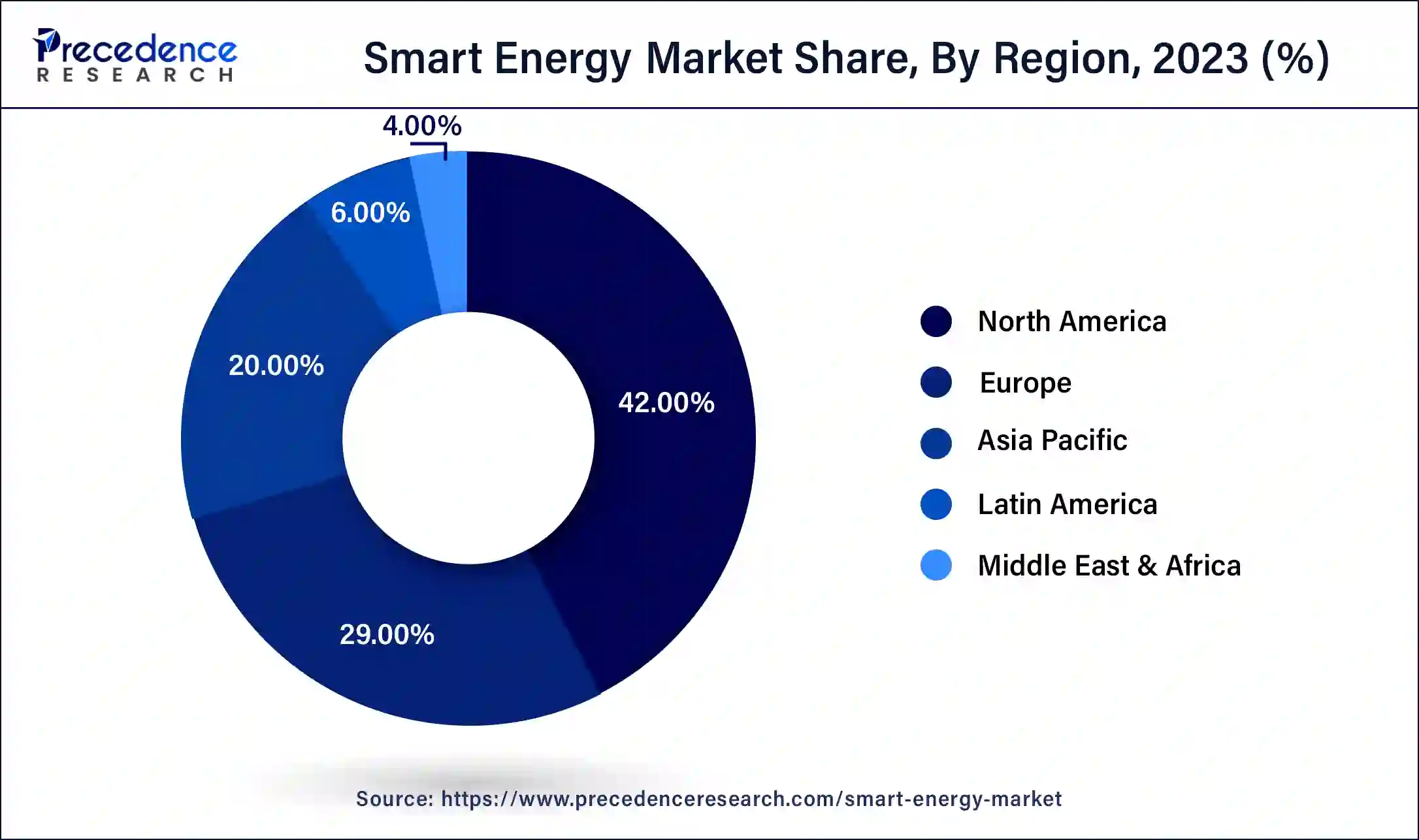September 2024
The global smart energy market size accounted for USD 177.71 billion in 2024, grew to USD 196.37 billion in 2025 and is projected to surpass around USD 482.31 billion by 2034, representing a healthy CAGR of 10.50% between 2024 and 2034.
The global smart energy market size is estimated at USD 177.71 billion in 2024 and is anticipated to reach around USD 482.31 billion by 2034, representing a healthy CAGR of 10.50% between 2024 and 2034.

The U.S. smart energy market size was valued at USD 47.28 billion in 2023 and is expected to be worth around USD 143.01 billion by 2034, growing at a CAGR of 10.59% from 2024 to 2034.

North America held the largest revenue share of 42% in 2023. In North America, the smart energy market is characterized by a strong focus on grid modernization, driven by the need for resilient and sustainable energy infrastructure. The region sees substantial investments in smart grid technologies, IoT applications, and renewable energy integration. Policies promoting clean energy, coupled with a robust technological ecosystem, contribute to the growth of the smart energy market in North America.

Asia Pacific is estimated to observe the fastest expansion. The region is experiencing a notable rise in smart energy endeavors, propelled by swift urbanization and a growing need for dependable and efficient energy solutions. Significant investments from governments in countries such as China and India are directed towards extensive smart grid implementations, renewable energy ventures, and the adoption of IoT-driven energy management systems. The region's vibrant market dynamics and dedicated pursuit of sustainable development solidify Asia-Pacific's role as a pivotal force driving advancements in the global smart energy market.
In Europe, the smart energy market is characterized by a progressive shift towards sustainable energy practices. The region emphasizes renewable energy integration, smart grid advancements, and innovative energy management solutions. European countries are at the forefront of adopting clean energy technologies, with a strong focus on reducing carbon emissions. Government incentives and stringent environmental regulations further propel the growth of the smart energy market in Europe.
The smart energy market encompasses innovative technologies and solutions aimed at optimizing energy production, distribution, and consumption through advanced digital systems. Utilizing smart grids, IoT devices, and data analytics, it enables efficient management of energy resources.
The market promotes sustainability by integrating renewable energy sources, enhancing grid reliability, and empowering consumers with real-time energy monitoring and control. Key players include technology providers, utility companies, and solution developers. As the world shifts towards cleaner and more intelligent energy systems, the smart energy Market plays a crucial role in advancing the transition to a sustainable and digitally connected energy ecosystem.
| Report Coverage | Details |
| Growth Rate from 2024 to 2034 | CAGR of 10.50% |
| Market Size in 2024 | USD 177.71 Billion |
| Market Size by 2034 | USD 482.31 Billion |
| Largest Market | North America |
| Base Year | 2023 |
| Forecast Period | 2024 to 2034 |
| Segments Covered | Product, End-User Industry, and Region |
| Regions Covered | North America, Europe, Asia-Pacific, Latin America, and Middle East & Africa |
Renewable energy integration and IoT advancements
The smart energy market experiences a surge in demand propelled by the integration of renewable energy and advancements in the Internet of Things (IoT). The imperative shift towards cleaner energy sources, such as solar and wind, necessitates sophisticated solutions for seamless integration into existing energy grids. Smart energy systems enable efficient management of renewable sources, optimizing their contribution to the overall energy mix and meeting sustainability goals.
Simultaneously, the continuous advancements in IoT play a pivotal role in driving market demand. IoT technologies empower smart energy solutions with real-time monitoring, control, and data analytics capabilities. This allows for precision in energy consumption patterns, predictive maintenance, and grid optimization. The synergy between renewable energy integration and IoT advancements not only enhances the reliability and efficiency of energy systems but also contributes significantly to the global transition towards sustainable and intelligent energy ecosystems.
Moreover, rising energy efficiency demands fuel market growth by compelling businesses and consumers to adopt energy-efficient solutions. As environmental awareness increases, there is a growing emphasis on sustainable practices, driving the demand for technologies that optimize energy consumption. This surge in demand stimulates innovation, promoting the development and adoption of energy-efficient products and services. Companies catering to these demands not only meet regulatory requirements but also contribute to a more sustainable future, fostering robust growth in the energy efficiency market.
Interoperability challenges and limited consumer awareness
One significant factor hindering the market demand for smart energy solutions is interoperability challenges. The diverse array of devices, systems, and technologies within the smart energy ecosystem often face compatibility issues, impeding seamless communication and integration. Interoperability challenges can lead to inefficiencies, increased costs, and operational complexities for both providers and consumers. The lack of standardized protocols and communication frameworks poses a barrier to the cohesive functioning of interconnected devices, limiting the broader adoption of smart energy technologies across the ecosystem.
Another restraint on the market demand is the limited awareness among consumers regarding the benefits and functionalities of smart energy solutions. Many consumers remain unfamiliar with the potential cost savings, environmental advantages, and overall efficiency improvements that smart energy technologies can offer. The lack of awareness contributes to a slower rate of adoption, as potential users may not fully grasp the value proposition of these technologies. Education and outreach efforts are essential to overcome this barrier, fostering a better understanding of the advantages of smart energy solutions and driving increased consumer interest and demand.
Smart grid solutions and IoT-based energy management
Smart grid solutions play a pivotal role in surging the demand for the smart energy market by revolutionizing the traditional energy infrastructure. These solutions integrate advanced communication, control, and automation technologies into the electricity grid, enhancing its efficiency, reliability, and sustainability.
With features such as real-time data analytics, grid monitoring, and demand response capabilities, smart grids enable seamless integration of renewable energy sources, grid optimization, and efficient energy distribution. The increased focus on reducing energy losses, improving resilience against disruptions, and accommodating the growing demand for electric vehicles contributes to the escalating demand for smart grid solutions in the smart energy market.
Moreover, IoT-based energy management solutions are instrumental in driving market demand by providing real-time visibility and control over energy consumption. These technologies leverage interconnected devices and sensors to gather and analyze data, allowing businesses and consumers to optimize energy usage. By enabling smarter decision-making, predictive maintenance, and demand response strategies, IoT-based energy management fosters a more efficient and sustainable energy ecosystem. The surge in the adoption of smart devices, coupled with the need for cost-effective and environmentally conscious energy practices, positions IoT-based solutions as a key driver in meeting the evolving demands of the smart energy market.
Government initiatives play a pivotal role in surging market growth by providing policy frameworks, incentives, and funding support. Policies promoting renewable energy, smart infrastructure, and energy efficiency drive investments and innovation. Subsidies, tax credits, and regulatory support encourage businesses to adopt sustainable practices. These initiatives create a conducive environment, fostering collaboration between the public and private sectors, thereby accelerating market growth in areas like clean energy, smart grids, and sustainable technologies.
The smart grid segment has hold a 39% revenue share in 2023. A smart grid refers to an advanced electricity distribution system that utilizes digital communication and technology to efficiently monitor, control, and optimize the flow of electricity. It integrates renewable energy sources, enhances grid reliability, and supports two-way communication between utilities and consumers. Trends in smart grids include the incorporation of artificial intelligence (AI) for predictive analytics, increased use of sensors for real-time monitoring, and the deployment of microgrids for localized energy distribution, promoting a more resilient and responsive energy infrastructure.
The smart solar segment is anticipated to expand at a significant CAGR of 14.1% during the projected period. Smart solar solutions involve the integration of digital technologies to enhance the efficiency and management of solar energy systems. These solutions encompass IoT-enabled solar panels, smart inverters, and monitoring systems. Key trends include the use of predictive analytics for optimal solar power generation, advanced tracking systems for improved sunlight capture, and the integration of energy storage solutions to address intermittency, contributing to a more intelligent and reliable utilization of solar energy in the smart energy market.
The industrial segment is anticipated to hold the largest market share of 57% in 2023. In the smart energy market, industrial end-users focus on implementing intelligent technologies to enhance operational efficiency, reduce energy consumption, and ensure sustainability. Industrial trends include the integration of smart sensors for real-time monitoring, predictive maintenance through IoT, and the adoption of energy analytics for optimized resource utilization. These innovations empower industries to streamline production processes, minimize downtime, and contribute to eco-friendly practices, aligning with the growing emphasis on sustainable industrial operations.
The commercial segment is projected to grow at the fastest rate over the projected period. In the commercial sector, businesses leverage smart energy solutions for efficient building management, lighting, and HVAC systems. Noteworthy trends encompass the adoption of smart meters, energy-efficient lighting, and automated energy management systems in the commercial sector. These technologies empower businesses to oversee and regulate energy consumption, leading to reduced operational costs and compliance with environmental standards. The commercial segment increasingly values the deployment of intelligent systems to create energy-efficient and comfortable spaces while meeting corporate sustainability goals.
Segments Covered in the Report
By Product
By End-User Industry
By Geography
For inquiries regarding discounts, bulk purchases, or customization requests, please contact us at sales@precedenceresearch.com
No cookie-cutter, only authentic analysis – take the 1st step to become a Precedence Research client
September 2024
August 2024
January 2025
January 2025